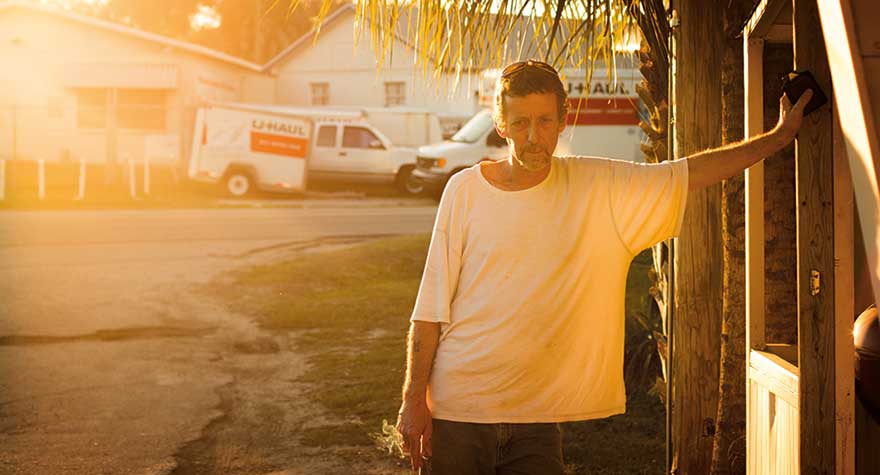
Rehabilitation and redemption are the goals for a community of registered sex offenders in this tough-to-watch film.

Rehabilitation and redemption are the goals for a community of registered sex offenders in this tough-to-watch film.
Registered. Sex. Offender.
It’s hard to think of three other words that together elicit a more immediate and visceral sense of ill ease. Anecdotally, it seems the Registered Sex Offender receives less contextual benefit of the doubt than any other criminal. Maybe the thief was desperate and acted out of survival. Maybe the killer took a life in self-defense. Maybe the drunk driver hasn’t gotten proper help to tackle that addiction. With a Registered Sex Offender, though, guilt is never about maybes and always about degree. This is just one facet that directors Frida Barkfors and Lasse Barkfors tackle when they examine Registered Sex Offenders—or at least a very specific group of them—in Pervert Park, their Sundance Special Jury prize-winning documentary.
More formally known as Florida Justice Transitions, “Pervert Park” is a mobile home community in St. Petersburg, FL, where 120 registered sex offenders have made their home. The Park was founded by Nancy Morais, whose son—himself a registered sex offender—struggled to find a community that would accept him after getting released from jail. Every resident of the Park is on some form of parole or probation, and most live there for the duration of that stage of their punishment. While there, each resident receives counseling for two years. Morais has since retired, but the Park is managed and maintained by former residents. The film focuses on the stories of a select group of individuals who live there.
What a group of individuals that is, and what a film this is. Tackling sex offenders—especially a collection of them whose crimes involved, or were committed against, children—is no easy task. As the film’s subjects are quick to reiterate, prejudgement of the guilty reigns supreme in our society. The Backfors deftly counter this with a shrewd 1-2 combination.
First, they present what appears to be the stark truth about each offender as told by each offender. While there might be details omitted or blurred, each person fully admits to having committed the crime for which they have been found guilty. A couple of stories suggest unfortunate circumstances or even entrapment, while others confess to having done wrong, but no one says, “It wasn’t me.” Culpability is unanimous. Because these tales are told from the perspective of the perpetrator, they carry a unique weight.
Adding to that weight are the backstories of some of the offenders. Bill Fuery, the park’s maintenance man and primary subject of the film, had a horrendous childhood, and went through an even greater tragedy into his early adult life. Another offender spotlighted is the sole female subject of the film, Tracy Hutchinson. Her backstory, which she tells in detail, is simply unthinkable, haunting the mind long after the closing credits. It’s important to note, though, that not every backstory is as dramatic as these, and none of the stories are ever framed as justification for the crimes committed. Instead, they are offered as a way to make clear the offenders aren’t monsters; they’re people. They are also working hard at becoming better.
From a storytelling perspective, the co-writers/co-directors have an excellent feel for timing. No single story is told in one large chunk. Instead, each story is broken up in at least two parts, and longer stories like Fuery’s and Hutchinson’s are doled out across most of the film. Their stories in particular work well in this format, as there are multiple “WOW” moments for each of them. It might all sound dramatic, but it’s effective.
These backstories segue to the back-end of that 1-2 combination. Critical to the film’s success is what the Backfors don’t offer: rebuttal. This is not a primetime TV news magazine looking to make viewers judge and jury; this is a film where the directors know most viewers will already have a preconceived notion of the subjects, so there is no need (in this context) to present any “case” against these people. They know what they’ve committed, they all know how wrong it was, and they all know the scope of the damage done.
The film also presents a higher-level look at the residents as a collective, the (seemingly) positive effects of therapy in both individual and group settings, and some interesting statistics about sex offenders and recidivism when measured against other crimes, and when compared to the Florida Justice Transitions program specifically.
There are times, though, when the film wants to make a statement against “the system” as a greater whole, questioning the benefit of incarceration vs. therapy. It also includes some loose comments about the perceived overeagerness of law enforcement when it comes to capturing (read: entrapping) offenders. While these points are both valid and worth examination, how they are presented in the film borders on irresponsible, as they are mostly hollow accusations that feel like they are meant to elicit a visceral “damn the man” response from the viewer as (hopeful) cheap points for its subjects. No points should be awarded.
Because of its subject matter, Pervert Park is a challenging watch, but one very much worth the effort. Over the course of the film’s lean 77-minute run time, the filmmakers find success in presenting their subjects as honestly as possible. They don’t ask for sympathy, but they do ask for consideration, and they earn it.